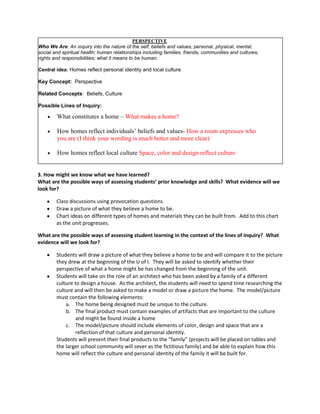Perspective planner what_we_have_learned
•Transferir como DOCX, PDF•
0 gostou•936 visualizações
Denunciar
Compartilhar
Denunciar
Compartilhar

Recomendados
Recomendados
Mais conteúdo relacionado
Mais procurados
Mais procurados (20)
PowerPoint Presentation 1: Overview of Learning Theories

PowerPoint Presentation 1: Overview of Learning Theories
Infographics in Education: Visualizing Information 

Infographics in Education: Visualizing Information
Personalized Learning: A Guide for Engaging Students with Technology

Personalized Learning: A Guide for Engaging Students with Technology
Semelhante a Perspective planner what_we_have_learned
Evaluating messages or images of different types of texts reflecting different culturesEvaluating messages or images of different types of texts reflecting differen...

Evaluating messages or images of different types of texts reflecting differen...PhDEng Ruel Bongcansiso
Semelhante a Perspective planner what_we_have_learned (20)
Evaluating messages or images of different types of texts reflecting differen...

Evaluating messages or images of different types of texts reflecting differen...
EDU203 - Literacy and LanguageName __________________________

EDU203 - Literacy and LanguageName __________________________
The Question is the Answer: Making the Language Arts Classroom Meaningful wit...

The Question is the Answer: Making the Language Arts Classroom Meaningful wit...
Humanities and Social Science (PBL, Learning Plan)

Humanities and Social Science (PBL, Learning Plan)
Perspective planner what_we_have_learned
- 1. 3. How might we know what we have learned? What are the possible ways of assessing students’ prior knowledge and skills? What evidence will we look for? Class discussions using provocation questions. Draw a picture of what they believe a home to be. Chart ideas on different types of homes and materials they can be built from. Add to this chart as the unit progresses. What are the possible ways of assessing student learning in the context of the lines of inquiry? What evidence will we look for? Students will draw a picture of what they believe a home to be and will compare it to the picture they drew at the beginning of the U of I. They will be asked to identify whether their perspective of what a home might be has changed from the beginning of the unit. Students will take on the role of an architect who has been asked by a family of a different culture to design a house. As the architect, the students will need to spend time researching the culture and will then be asked to make a model or draw a picture the home. The model/picture must contain the following elements: a. The home being designed must be unique to the culture. b. The final product must contain examples of artifacts that are important to the culture and might be found inside a home c. The model/picture should include elements of color, design and space that are a reflection of that culture and personal identity. Students will present their final products to the “family” (projects will be placed on tables and the larger school community will sever as the fictitious family) and be able to explain how this home will reflect the culture and personal identity of the family it will be built for. PERSPECTIVE Who We Are: An inquiry into the nature of the self; beliefs and values; personal, physical, mental, social and spiritual health; human relationships including families, friends, communities and cultures; rights and responsibilities; what it means to be human. Central idea: Homes reflect personal identity and local culture Key Concept: Perspective Related Concepts: Beliefs, Culture Possible Lines of Inquiry: What constitutes a home – What makes a home? How homes reflect individuals’ beliefs and values- How a room expresses who you are (I think your wording is much better and more clear) How homes reflect local culture Space, color and design reflect culture